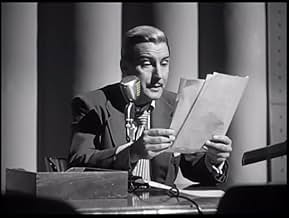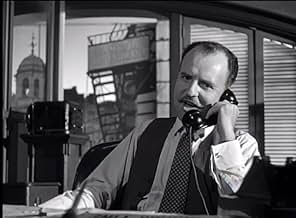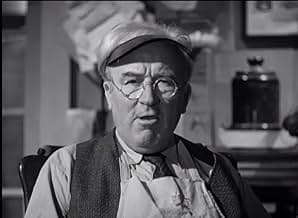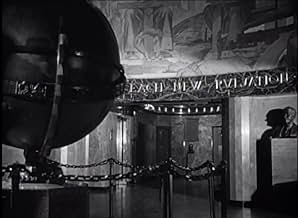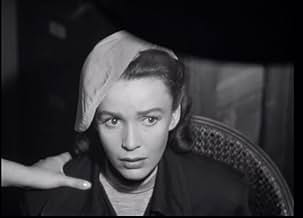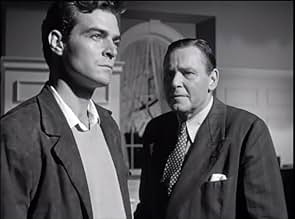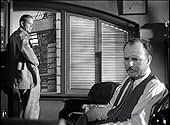IMDb RATING
6.9/10
1.5K
YOUR RATING
The story of the fight of a small-town newspaper to free an innocent girl of a murder charge, with the publisher of a metropolitan city newspaper heading, by forced circumstances, the opposi... Read allThe story of the fight of a small-town newspaper to free an innocent girl of a murder charge, with the publisher of a metropolitan city newspaper heading, by forced circumstances, the opposing forces.The story of the fight of a small-town newspaper to free an innocent girl of a murder charge, with the publisher of a metropolitan city newspaper heading, by forced circumstances, the opposing forces.
- Director
- Writers
- Stars
Howard Da Silva
- Carl Durham
- (as Howard da Silva)
Jay Adler
- Munsey's Assistant
- (uncredited)
- Director
- Writers
- All cast & crew
- Production, box office & more at IMDbPro
Featured reviews
Duryea's Mike Reese has all the scruples of a pinball with about that many scheming twists and turns. It's perfect casting for that unusual performer. Fired from a city newspaper, reporter Reese uses mob money to buy into a sleepy suburban paper, where he exploits a sensational murder for private gain.
For its time, the movie's about as cynical as they come. Still, this crime drama's a genuine sleeper with few punches pulled until the Code enforced ending that unfortunately isn't very convincing. What the story does show in fairly unsparing style is how corruption can reach into a town's highest levels. The narrative is pretty plot heavy so you may need the proverbial scorecard. But it's an intelligent screenplay, providing plausible motivation for the various misdeeds.
I suspect the movie's title comes from the role the underworld plays in doing the dirty work for more respectable members of society, and then exploiting the connection for nefarious purposes (Stanton & Durham). It's the connection between the two worlds that appears to be the main theme. DeSilva plays the mob boss in unusually jovial fashion (perhaps too much), along with occasional hints of snarling menace.
I wouldn't expect a cheerleader type like Gale Storm to be in a crime movie, but she does a believable job as the struggling suburban publisher, put into a fix by her recently deceased dad. I kept expecting something to develop between her and the high-powered Reese, but this is not a movie of clichés.
As I recall, the film was taken to task for casting a white woman (Anderson) in the important role of the "Negro" maid Molly. Now, there's a question of why the maid would be made a Black woman in the first place since her race is not a factor in plot development. And second, why cast an obvious white woman in the part, which only invites unneeded curiosity. I'm not sure what the answers are, but leftist writer Blankfort and director Endfield may have wanted to make a racial statement that didn't make it to the screen. But whatever the reason, the casting remains a false note in an otherwise thoughtful screenplay.
Several notable social themes do emerge. Note how easily a well-meaning public is fleeced by Reese and the shyster lawyer, after offering up their hard earned money to the defense committee. Then there's the town's wealthy establishment that can ruin anyone who crosses them, including Reese and his newspaper. Or the yellow journalism that will print whatever promises to make money. Just as importantly, these key topics play out in fairly subtle, non-preaching fashion.
Director Endfield shows here, as in his powerful Sound of Fury, aka Try and Get Me (1950), that given the chance away from his Joe Palooka programmers, he could do social conscience films with the best of them. Note the many careful touches in this film—the shabby people lined up to donate to the defense committee, the defining bust of Napoleon discretely behind editor Lee's (Dunne) desk, Lee slyly opening the door behind Reese despite what he's saying. Too bad Endfield finished his career in England after falling victim to the blacklist.
All in all, the movie's not as powerful as Sound of Fury, but it does avoid clichés and remains consistently engaging and unpredictable. Endfield appears fascinated in both films with yellow journalism and how it's used to exploit society, a worthy topic for any period. Editor Reese is nothing if not entrepreneurial in his schemes, with the money-making ideas spitting out as fast as a machine gun. It's an impressive lead performance by the great Duryea. Anyway, except for the occasionally cheap sets and unconvincing climax, this obscure indie production remains a genuine sleeper.
For its time, the movie's about as cynical as they come. Still, this crime drama's a genuine sleeper with few punches pulled until the Code enforced ending that unfortunately isn't very convincing. What the story does show in fairly unsparing style is how corruption can reach into a town's highest levels. The narrative is pretty plot heavy so you may need the proverbial scorecard. But it's an intelligent screenplay, providing plausible motivation for the various misdeeds.
I suspect the movie's title comes from the role the underworld plays in doing the dirty work for more respectable members of society, and then exploiting the connection for nefarious purposes (Stanton & Durham). It's the connection between the two worlds that appears to be the main theme. DeSilva plays the mob boss in unusually jovial fashion (perhaps too much), along with occasional hints of snarling menace.
I wouldn't expect a cheerleader type like Gale Storm to be in a crime movie, but she does a believable job as the struggling suburban publisher, put into a fix by her recently deceased dad. I kept expecting something to develop between her and the high-powered Reese, but this is not a movie of clichés.
As I recall, the film was taken to task for casting a white woman (Anderson) in the important role of the "Negro" maid Molly. Now, there's a question of why the maid would be made a Black woman in the first place since her race is not a factor in plot development. And second, why cast an obvious white woman in the part, which only invites unneeded curiosity. I'm not sure what the answers are, but leftist writer Blankfort and director Endfield may have wanted to make a racial statement that didn't make it to the screen. But whatever the reason, the casting remains a false note in an otherwise thoughtful screenplay.
Several notable social themes do emerge. Note how easily a well-meaning public is fleeced by Reese and the shyster lawyer, after offering up their hard earned money to the defense committee. Then there's the town's wealthy establishment that can ruin anyone who crosses them, including Reese and his newspaper. Or the yellow journalism that will print whatever promises to make money. Just as importantly, these key topics play out in fairly subtle, non-preaching fashion.
Director Endfield shows here, as in his powerful Sound of Fury, aka Try and Get Me (1950), that given the chance away from his Joe Palooka programmers, he could do social conscience films with the best of them. Note the many careful touches in this film—the shabby people lined up to donate to the defense committee, the defining bust of Napoleon discretely behind editor Lee's (Dunne) desk, Lee slyly opening the door behind Reese despite what he's saying. Too bad Endfield finished his career in England after falling victim to the blacklist.
All in all, the movie's not as powerful as Sound of Fury, but it does avoid clichés and remains consistently engaging and unpredictable. Endfield appears fascinated in both films with yellow journalism and how it's used to exploit society, a worthy topic for any period. Editor Reese is nothing if not entrepreneurial in his schemes, with the money-making ideas spitting out as fast as a machine gun. It's an impressive lead performance by the great Duryea. Anyway, except for the occasionally cheap sets and unconvincing climax, this obscure indie production remains a genuine sleeper.
When the story begins, newspaper man Mike Reese (Dan Duryea) is fired from a big city paper for unethical conduct...conduct that resulted in someone's murder by the local mob boss, Durham (Howard Da Silva). Not surprisingly, he's fired and no one will hire him.
He soon finds himself in a small town and gets himself a job with a tiny, unimportant paper. However, when a rich and very important lady is murdered, he sees it as a chance to make it back to the big time papers. He champions the cause of the woman accused of the murder-- even though he probably doesn't believe in her innocence at all. However, through the course of the film something interesting happens...folks, including Durham, start pressuring Mike to drop the story. So, there must be something to all this and the fix is on...and suddenly the opportunistic and soulless guy is read to risk his life to do what is right! But he might just get himself killed in the process...and folks seem more than ready to oblige.
While this film isn't strictly a traditional film noir picture in some ways, as the plot isn't at all typical of noir, but it sure is noir in spirit. There are many dark and evil characters you'd see in a noir picture and there also is the morally challenged hero. But what's most noir about this film is the camera-work...with camera angles and shadows that you'd find in any decent noir picture.
This film proves that Dan Duryea was a heck of an actor. While he's normally known for playing greasy, pusillanimous jerks, here he has so much more to him and he is a great combination of grit, cynicism and, believe it or not, decency! Overall, a fantastic film that's undergone a recent revival in interest and is now seen by many as a classic. Classic? Yes, I can see that.
He soon finds himself in a small town and gets himself a job with a tiny, unimportant paper. However, when a rich and very important lady is murdered, he sees it as a chance to make it back to the big time papers. He champions the cause of the woman accused of the murder-- even though he probably doesn't believe in her innocence at all. However, through the course of the film something interesting happens...folks, including Durham, start pressuring Mike to drop the story. So, there must be something to all this and the fix is on...and suddenly the opportunistic and soulless guy is read to risk his life to do what is right! But he might just get himself killed in the process...and folks seem more than ready to oblige.
While this film isn't strictly a traditional film noir picture in some ways, as the plot isn't at all typical of noir, but it sure is noir in spirit. There are many dark and evil characters you'd see in a noir picture and there also is the morally challenged hero. But what's most noir about this film is the camera-work...with camera angles and shadows that you'd find in any decent noir picture.
This film proves that Dan Duryea was a heck of an actor. While he's normally known for playing greasy, pusillanimous jerks, here he has so much more to him and he is a great combination of grit, cynicism and, believe it or not, decency! Overall, a fantastic film that's undergone a recent revival in interest and is now seen by many as a classic. Classic? Yes, I can see that.
Why 'The Underworld Story'? I guess there are some underworld types present but the emphasis is not on the underworld. It's a story about a newspaper editor who has lost his moral compass and moves to the sticks. This is one very few pictures in which Dan Duryeas' name is above the title, and he does an excellent job. Those of us who count him among our favorite character actors will not be disappointed in his star turn here. Complete with sardonic grin and usual wisecracks, he is in his element as the editor-in-search-of-scruples.
It carries the Warner Bros. patina - a gritty crime melodrama with a mix of social commentary and thick-ear rough stuff, and with a curious collection of supporting characters. Howard Da Silva, Gale Storm, Michael O'Shea and Harry Shannon all do themselves credit and Herbert Marshall(?) also manages to fit in.
This is a good semi-noir. It starts off as one but switches in mid-picture to straight drama and then back again. Only 90" long, it holds your interest throughout. It may not sound promising but sometimes you can't judge a movie by its title.
It carries the Warner Bros. patina - a gritty crime melodrama with a mix of social commentary and thick-ear rough stuff, and with a curious collection of supporting characters. Howard Da Silva, Gale Storm, Michael O'Shea and Harry Shannon all do themselves credit and Herbert Marshall(?) also manages to fit in.
This is a good semi-noir. It starts off as one but switches in mid-picture to straight drama and then back again. Only 90" long, it holds your interest throughout. It may not sound promising but sometimes you can't judge a movie by its title.
10dcole-2
Dan Duryea is one of the best actors out there, able to play the slimiest slime-ball and the staunchest of heroes. Here he does a little of both and you're never sure which side he's on. The movie starts as a Noir Crime Thriller, then becomes a 30's-style social drama, then switches back to noir and crime -- but it never loses its style, its verve and its pace. Constantly fun and involving, due to Duryea's movable morals -- and to Stanley Cortez's gorgeous black-and-white cinematography. Director/Writer Endfield does a fine job keeping things going, setting up interesting shots and corralling a cast that's great down to every tiny part. Bad Guy Howard Da Silva chews the scenery with relaxed gusto and is a joy to watch. Highly recommended.
Dan Duryea stars as Mike Reese, a big-city newspaperman who is black-balled out of town after publishing a story that helps a mobster rub out an informant. Reese settles in the nearby small town of Lakewood, where he buys a half interest in a newspaper owned by Cathy Harris (Gale Storm). Just as soon as he does, the biggest story to hit Lakewood in decades breaks: the daughter-in-law of E. J. Stanton (Herbert Marshall), the town's wealthiest resident, is found murdered. Reese's experience at bigger papers helps the little operation get the scoop on the out-of-town outfits, but it places Reese and Cathy in the cross-hairs of powers more dangerous than they realize.
A mash-up of newspaper drama, small-town expose, and gangster picture, some of this works, but not a lot. The Reese character is neither helped or hindered by the casting of Duryea: if it was the filmmakers' intention to keep the audience guessing whether or not he was a slime ball at heart or was decent beneath the surface, then Duryea is a good pick, as I still wasn't sure by the end how much of a creep he really was. I say all of this as somebody who is an overall big fan of Dan Duryea. Marshall was awful, turning in an amateur-level performance during his big emotional scenes, although he was never exactly great at that kind of thing. Gale Storm didn't make much of an impression, either. Howard DaSilva has a couple of good scenes as the chief gang boss. This was the final film appearance for Edward Van Sloan, who had been a mainstay in Universal's horror films of the 1930's.
A mash-up of newspaper drama, small-town expose, and gangster picture, some of this works, but not a lot. The Reese character is neither helped or hindered by the casting of Duryea: if it was the filmmakers' intention to keep the audience guessing whether or not he was a slime ball at heart or was decent beneath the surface, then Duryea is a good pick, as I still wasn't sure by the end how much of a creep he really was. I say all of this as somebody who is an overall big fan of Dan Duryea. Marshall was awful, turning in an amateur-level performance during his big emotional scenes, although he was never exactly great at that kind of thing. Gale Storm didn't make much of an impression, either. Howard DaSilva has a couple of good scenes as the chief gang boss. This was the final film appearance for Edward Van Sloan, who had been a mainstay in Universal's horror films of the 1930's.
Did you know
- TriviaThe "N" word is overdubbed with "Negro" on at least two occasions. [Note: this may be a local station's practice; the version shown on TCM contains the uncensored language.]
- GoofsAt the funeral, there is a headstone marked "Robert Elis 1720-1777". After the service, as the mourners are leaving, the same headstone appears in a completely different place.
- Quotes
District Attorney Ralph Munsey: Take it easy, Reese. Things are tough all over. Pretty soon a man won't be able to sell his own mother.
- Alternate versionsThe manufacture-on-demand DVD from Warner Archive Collection has the opening and closing 1992 Warner Bros. Pictures logos.
- ConnectionsReferences Le chant de Bernadette (1943)
- How long is The Underworld Story?Powered by Alexa
Details
- Release date
- Country of origin
- Language
- Also known as
- The Underworld Story
- Filming locations
- Los Angeles City Hall - 200 North Spring Street, Downtown, Los Angeles, California, USA("The Turk" was murdered on the steps of City Hall)
- Production company
- See more company credits at IMDbPro
- Runtime1 hour 31 minutes
- Color
- Aspect ratio
- 1.37 : 1
Contribute to this page
Suggest an edit or add missing content


